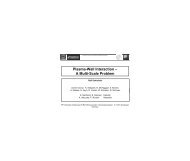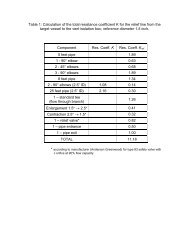The Nu-SNS proposal - ORNL Physics Division - Oak Ridge ...
The Nu-SNS proposal - ORNL Physics Division - Oak Ridge ...
The Nu-SNS proposal - ORNL Physics Division - Oak Ridge ...
You also want an ePaper? Increase the reach of your titles
YUMPU automatically turns print PDFs into web optimized ePapers that Google loves.
In addition to their effects prior to the formation of the supernova shock, charged-current<br />
neutrino capture (and neutral-current inelastic neutrino scattering [47]) on heavy nuclei above the<br />
shock can alter the entropy and neutronization of this infalling matter prior to its arrival at the<br />
shock. It has been suggested that if sufficient energy is transferred to this matter to melt a<br />
fraction of the nuclei, then the shock dynamics can be altered. Though this “pre-heating” of the<br />
shock could help the shock, it could also hinder the shock because the melted nuclei produce a<br />
higher pressure, reducing the Mach number of the shock. Potentially, these changes in the preshock<br />
matter affect not only the shock propagation but also the thermodynamic conditions in the<br />
post-shock convective region. Only with accurate neutrino-nucleus cross sections can we<br />
gauge the full impact of these interactions on the supernova mechanism and begin to<br />
answer the corresponding questions raised by Connecting Quarks with the Cosmos.<br />
3.3 Supernova <strong>Nu</strong>cleosynthesis<br />
Neutrinos impact all phases of supernova nucleosysnthesis.<br />
Supernova nucleosynthesis is commonly divided into several “processes”, each of which is<br />
impacted by neutrino-nucleus interactions. (1) Explosive nucleosynthesis occurs as a result of<br />
compressional heating by the supernova shock wave as it passes through the stellar layers. In the<br />
inner layers of the ejecta, where iron group nuclei result from α-rich freezeout, interactions with<br />
neutrinos alter the neutronization, changing the ultimate composition. (2) Neutrino<br />
nucleosynthesis or the “ν” process occurs due to neutrino-induced nuclear transmutations in the<br />
outer stellar layers followed by shock heating. (3) <strong>The</strong> rapid neutron capture or “r” process may<br />
occur in the neutrino-driven wind that emanates from the proto-neutron star after the explosion is<br />
initiated. <strong>The</strong> neutrinos both drive the wind and interact with the nuclei in it. Early phases of this<br />
wind have also been suggested as the source of light p-process nuclei [48]. Thus, neutrinonucleus<br />
interactions are important to all core collapse supernova nucleosynthesis processes.<br />
3.3.1 Neutrinos and the α-Rich Freezeout<br />
Neutrino interactions help determine the isotopic composition of the iron group ejecta.<br />
One common property exhibited by recent spherically symmetric Boltzmann simulations [13,14]<br />
is a decrease in the neutronization (which is equivalent to an increase in the electron fraction Y e )<br />
of the inner layers of the ejecta due to neutrino interactions. This is a feature that current<br />
parameterized nucleosynthesis models cannot replicate because they ignore the neutrino<br />
interactions. <strong>The</strong> neutronization of the ejecta is important because galactic chemical evolution<br />
calculations and the relative neutron-poverty of terrestrial iron and neighboring elements<br />
strongly limits the amount of neutronized material that may be ejected into the interstellar<br />
medium by core collapse supernovae [49]. Those previous multidimensional models for core<br />
collapse supernovae that did produce explosions tended to greatly exceed these limits (see, e.g.,<br />
[5,17,50]). To compensate, modelers have been forced to assume the fallback of a considerable<br />
amount of matter onto the neutron star, occurring on a timescale longer than was simulated.<br />
While the decreased neutronization seen in Boltzmann models reduces the need to invoke<br />
fallback, it also makes any fallback scenario more complicated, since the most neutron-rich<br />
material may no longer be the innermost.<br />
As a result of neutrino-nucleus interactions, the nucleosynthesis products from future explosion<br />
simulations (utilizing multi-group neutrino transport) will be qualitatively different, both in<br />
ν-<strong>SNS</strong> Proposal 26 8/4/2005



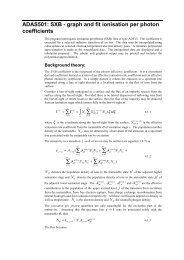
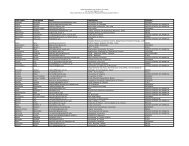
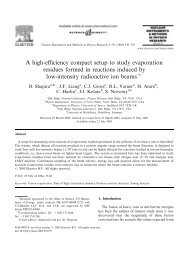
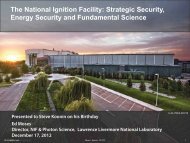

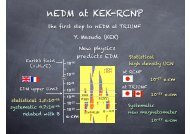
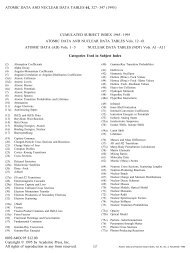


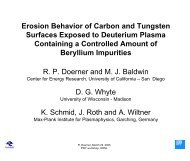
![Mixed-mode Calculations within the Nuclear Shell Model [pdf]](https://img.yumpu.com/28265410/1/190x146/mixed-mode-calculations-within-the-nuclear-shell-model-pdf.jpg?quality=85)
